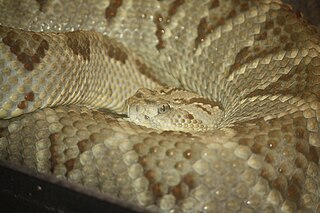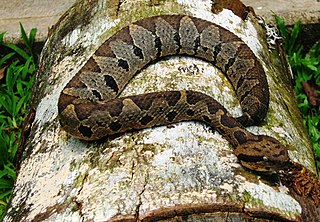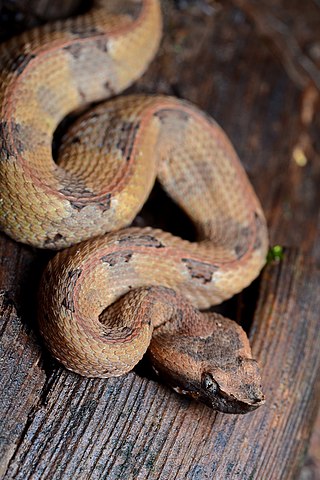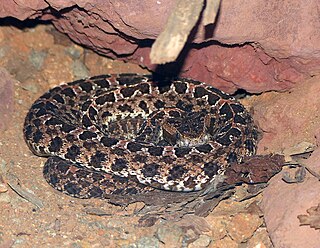
Metlapilcoatlus is a genus of pit vipers endemic to Mexico and Central America. Six species are currently recognized. The common names suggest they are able to leap at an attacker, but this is likely exaggerated. Common names for the species include jumping pitvipers and jumping vipers. The genus name comes from the Nahuatl name metlapilcohuatl, which means of the oblong grindstone held in the hand when grinding corn—alluding to the snake's short, stocky body.

Loxocemus bicolor, the sole member of the monotypic family Loxocemidae and commonly known as the Mexican python, Mexican burrowing python and Mexican burrowing snake, is a species of python-like snake found in Mexico and Central America. No subspecies are currently recognized. Analyses of DNA show that Loxocemus is most closely related to the true pythons and the sunbeam snakes.

Bothriechis is a genus of pit vipers, commonly called palm vipers or palm-pitvipers found predominantly in Mexico and Central America, although the most common species, B. schlegelii, ranges as far south as Colombia and Peru. All members are relatively slender and arboreal. The name Bothriechis is derived from the Greek words bothros and echis that mean "pit" and "viper" respectively. Ten species and no subspecies are currently generally recognized.

Cerrophidion is a genus of pit vipers which are endemic to southern Mexico, Central America, and western Panama. The generic name, Cerrophidion, is derived from the Spanish word cerro, which means "mountain", and the Greek word ophidion, which means "small snake". Five species are recognized as being valid, but no subspecies are.

Crotalus simus is a venomous pit viper species found in Mexico and Central America. The specific epithet is Latin for "flat-nosed", likely because its head is blunt compared with lanceheads (Bothrops). Three subspecies are recognized, including the nominate subspecies described here.

Crotalus intermedius is a pit viper species found in central and southern Mexico. Like all other pit vipers, it is venomous. Three subspecies are currently recognized, including the nominate subspecies described here.

Crotalus triseriatus is a venomous pit viper species found in Mexico. Two subspecies are currently recognized, including the nominate subspecies described here.

Bothriechis bicolor is a pit viper species found in southern Mexico, Guatemala and Honduras. The specific name refers to the contrasting ventral and dorsal colors. No subspecies are currently recognized.

Metlapilcoatlus nummifer, commonly known as Mexican jumping pit viper or jumping viper, is a pit viper species endemic to Mexico.

Metlapilcoatlus olmec is a pit viper species found in Mexico. No subspecies are currently recognized.

Bothriechis aurifer is a pit viper species found in Mexico and Guatemala. No subspecies are currently recognized.

Bothriechis rowleyi is a species of pit viper, a venomous snake, in the subfamily Crotalinae of the family Viperidae. The species is endemic to Mexico. There are no subspecies that are recognized as being valid.

Bothriechis marchi, also known as Honduran palm pit viper and March's palm pit viper, is a species of pit viper, a venomous snake, in the subfamily Crotalinae of the family Viperidae. The species is endemic to Central America. There are no subspecies that are recognized as being valid.

Cerrophidion godmani is a venomous pit viper species native to southern Mexico and Guatemala. No subspecies are recognized as being valid. It is also known commonly as Godman's montane pit viper or Godman's pit viper.

Cerrophidion tzotzilorum is a venomous pit viper species which is native to southern Mexico. There are no subspecies that are recognized as being valid.

Porthidium nasutum is a venomous pitviper species found in southern Mexico, Central America and northern South America. No subspecies are currently recognized.

Bothrops bilineatus, also known as the two-striped forest-pitviper, parrotsnake, Amazonian palm viper, or green jararaca, is a highly venomous pit viper species found in the Amazon region of South America. Two subspecies are currently recognized, including the nominate subspecies described here. A pale green arboreal species that may reach 1 m (3.3 ft) in length, it is an important cause of snakebite throughout the entire Amazon region.

Metlapilcoatlus mexicanus is a pit viper species endemic to Mexico and Central America.

Lachesis melanocephala is a species of venomous pit viper in the family Viperidae. The species is native to Costa Rica and Panama. There are no subspecies that are recognized as being valid.

Porthidium ophryomegas is a venomous pitviper species found in Central America. No subspecies are currently recognized.


















